Trends of Grassland Resilience under Climate Change and Human Activities on the Mongolian Plateau
Abstract
:1. Introduction
2. Materials and Methods
2.1. Study Area
2.2. Dataset
2.2.1. Land Cover Types
2.2.2. Climate Data
2.2.3. Vegetation Data
2.2.4. Human Activity Data
2.3. Methodology
2.3.1. Calculation of Resilience
2.3.2. Resilience Driver Analysis and Trend Calculation
3. Results
3.1. Grassland Resilience of the Mongolian Plateau and Its Key Drivers
3.2. Trend of Grassland Resilience on the Mongolian Plateau and Its Key Drivers
4. Discussion
4.1. Comparison of Grassland Resilience and Its Trend between Inner Mongolia and Mongolia
4.2. The Spatial Distribution and Drivers of Grassland Resilience and Its Trend on the Mongolian Plateau
4.3. Uncertainty of Method and Potential Future Improvement
5. Conclusions
Author Contributions
Funding
Data Availability Statement
Acknowledgments
Conflicts of Interest
References
- Folke, C.; Carpenter, S.; Walker, B.; Scheffer, M.; Elmqvist, T.; Gunderson, L.; Holling, C.S. Regime Shifts, Resilience, and Biodiversity in Ecosystem Management. Annu. Rev. Ecol. Evol. Syst. 2004, 35, 557–581. [Google Scholar] [CrossRef] [Green Version]
- Scheffer, M.; Carpenter, S.R.; Dakos, V.; van Nes, E.H. Generic Indicators of Ecological Resilience: Inferring the Chance of a Critical Transition. Annu. Rev. Ecol. Evol. Syst. 2015, 46, 145–167. [Google Scholar] [CrossRef]
- Feng, Y.; Su, H.; Tang, Z.; Wang, S.; Zhao, X.; Zhang, H.; Ji, C.; Zhu, J.; Xie, P.; Fang, J. Reduced resilience of terrestrial ecosystems locally is not reflected on a global scale. Commun. Earth Environ. 2021, 2, 88. [Google Scholar] [CrossRef]
- Levine, N.M.; Zhang, K.; Longo, M.; Baccini, A.; Phillips, O.L.; Lewis, S.L.; Alvarez-Dávila, E.; Segalin de Andrade, A.C.; Brienen, R.J.W.; Erwin, T.L.; et al. Ecosystem heterogeneity determines the ecological resilience of the Amazon to climate change. Proc. Natl. Acad. Sci. USA 2016, 113, 793–797. [Google Scholar] [CrossRef] [Green Version]
- Zhou, G.; Peng, C.; Li, Y.; Liu, S.; Zhang, Q.; Tang, X.; Liu, J.; Yan, J.; Zhang, D.; Chu, G. A climate change-induced threat to the ecological resilience of a subtropical monsoon evergreen broad-leaved forest in Southern China. Glob. Chang. Biol. 2013, 19, 1197–1210. [Google Scholar] [CrossRef] [PubMed]
- Boulton, C.A.; Lenton, T.M.; Boers, N. Pronounced loss of Amazon rainforest resilience since the early 2000s. Nat. Clim. Chang. 2022, 12, 271–278. [Google Scholar] [CrossRef]
- Gazol, A.; Camarero, J.J.; Anderegg, W.R.L.; Vicente-Serrano, S.M. Impacts of droughts on the growth resilience of Northern Hemisphere forests. Glob. Ecol. Biogeogr. 2017, 26, 166–176. [Google Scholar] [CrossRef]
- Xiao, W.; Lv, X.; Zhao, Y.; Sun, H.; Li, J. Ecological resilience assessment of an arid coal mining area using index of entropy and linear weighted analysis: A case study of Shendong Coalfield, China. Ecol. Indic. 2020, 109, 105843. [Google Scholar] [CrossRef]
- Pei, T.; Xu, J.; Liu, Y.; Huang, X.; Zhang, L.; Dong, W.; Qin, C.; Song, C.; Gong, J.; Zhou, C. GIScience and remote sensing in natural resource and environmental research: Status quo and future perspectives. Geogr. Sustain. 2021, 2, 207–215. [Google Scholar] [CrossRef]
- Sturm, J.; Santos, M.J.; Schmid, B.; Damm, A. Satellite data reveal differential responses of Swiss forests to unprecedented 2018 drought. Glob. Chang. Biol. 2022, 28, 2956–2978. [Google Scholar] [CrossRef]
- Seddon, A.W.R.; Macias-Fauria, M.; Long, P.R.; Benz, D.; Willis, K.J. Sensitivity of global terrestrial ecosystems to climate variability. Nature 2016, 531, 229–232. [Google Scholar] [CrossRef] [Green Version]
- Dakos, V.; Carpenter, S.R.; van Nes, E.H.; Scheffer, M. Resilience indicators: Prospects and limitations for early warnings of regime shifts. Philos. Trans. R. Soc. B Biol. Sci. 2015, 370, 20130263. [Google Scholar] [CrossRef] [Green Version]
- Scheffer, M.; Bascompte, J.; Brock, W.A.; Brovkin, V.; Carpenter, S.R.; Dakos, V.; Held, H.; van Nes, E.H.; Rietkerk, M.; Sugihara, G. Early-warning signals for critical transitions. Nature 2009, 461, 53–59. [Google Scholar] [CrossRef]
- Smith, T.; Traxl, D.; Boers, N. Empirical evidence for recent global shifts in vegetation resilience. Nat. Clim. Chang. 2022, 12, 477–484. [Google Scholar] [CrossRef]
- Smith, T.; Boers, N. Global vegetation resilience linked to water availability and variability. Nat. Commun. 2023, 14, 498. [Google Scholar] [CrossRef] [PubMed]
- Verbesselt, J.; Umlauf, N.; Hirota, M.; Holmgren, M.; Van Nes, E.H.; Herold, M.; Zeileis, A.; Scheffer, M. Remotely sensed resilience of tropical forests. Nat. Clim. Chang. 2016, 6, 1028–1031. [Google Scholar] [CrossRef]
- Forzieri, G.; Dakos, V.; McDowell, N.G.; Ramdane, A.; Cescatti, A. Emerging signals of declining forest resilience under climate change. Nature 2022, 608, 534–539. [Google Scholar] [CrossRef]
- Bengtsson, J.; Bullock, J.M.; Egoh, B.; Everson, C.; Everson, T.; O’Connor, T.; O’Farrell, P.J.; Smith, H.G.; Lindborg, R. Grasslands—More important for ecosystem services than you might think. Ecosphere 2019, 10, e02582. [Google Scholar] [CrossRef]
- Boval, M.; Dixon, R.M. The importance of grasslands for animal production and other functions: A review on management and methodological progress in the tropics. Animal 2012, 6, 748–762. [Google Scholar] [CrossRef] [Green Version]
- Bai, Y.; Cotrufo, M.F. Grassland soil carbon sequestration: Current understanding, challenges, and solutions. Science 2022, 377, 603–608. [Google Scholar] [CrossRef]
- Petermann, J.S.; Buzhdygan, O.Y. Grassland biodiversity. Curr. Biol. 2021, 31, R1195–R1201. [Google Scholar] [CrossRef] [PubMed]
- Oliver, T.H.; Heard, M.S.; Isaac, N.J.B.; Roy, D.B.; Procter, D.; Eigenbrod, F.; Freckleton, R.; Hector, A.; Orme, C.D.L.; Petchey, O.L.; et al. Biodiversity and Resilience of Ecosystem Functions. Trends Ecol. Evol. 2015, 30, 673–684. [Google Scholar] [CrossRef] [PubMed] [Green Version]
- Hoover, D.L.; Knapp, A.K.; Smith, M.D. Resistance and resilience of a grassland ecosystem to climate extremes. Ecology 2014, 95, 2646–2656. [Google Scholar] [CrossRef] [Green Version]
- Abdel-Hamid, A.; Dubovyk, O.; Graw, V.; Greve, K. Assessing the impact of drought stress on grasslands using multi-temporal SAR data of Sentinel-1: A case study in Eastern Cape, South Africa. Eur. J. Remote Sens. 2020, 53, 3–16. [Google Scholar] [CrossRef]
- Chen, L.; Sofia, G.; Qiu, J.; Wang, J.; Tarolli, P. Grassland ecosystems resilience to drought: The role of surface water ponds. Land Degrad. Dev. 2022, 34, 1960–1972. [Google Scholar] [CrossRef]
- Yao, Y.; Fu, B.; Liu, Y.; Li, Y.; Wang, S.; Zhan, T.; Wang, Y.; Gao, D. Evaluation of ecosystem resilience to drought based on drought intensity and recovery time. Agric. For. Meteorol. 2022, 314, 108809. [Google Scholar] [CrossRef]
- Tuya, W. Characteristics of grassland utilization in Mongolian Plateauand their differences among countries. Acta Geogr. Sin. 2021, 76, 1722–1731. [Google Scholar] [CrossRef]
- Gao, H.; Huang, Y. Impacts of the Three-North shelter forest program on the main soil nutrients in Northern Shaanxi China: A meta-analysis. For. Ecol. Manag. 2020, 458, 117808. [Google Scholar] [CrossRef]
- Nandintsetseg, B.; Shinoda, M.; Du, C.; Munkhjargal, E. Cold-season disasters on the Eurasian steppes: Climate-driven or man-made. Sci. Rep. 2018, 8, 14769. [Google Scholar] [CrossRef] [Green Version]
- Zhang, Y.; Wang, Q.; Wang, Z.; Yang, Y.; Li, J. Impact of human activities and climate change on the grassland dynamics under different regime policies in the Mongolian Plateau. Sci. Total Environ. 2020, 698, 134304. [Google Scholar] [CrossRef]
- Jamiyansharav, K.; Fernández-Giménez, M.E.; Angerer, J.P.; Yadamsuren, B.; Dash, Z. Plant community change in three Mongolian steppe ecosystems 1994–2013: Applications to state-and-transition models. Ecosphere 2018, 9, e02145. [Google Scholar] [CrossRef] [Green Version]
- Nandintsetseg, B.; Boldgiv, B.; Chang, J.; Ciais, P.; Davaanyam, E.; Batbold, A.; Bat-Oyun, T.; Stenseth, N.C. Risk and vulnerability of Mongolian grasslands under climate change. Environ. Res. Lett. 2021, 16, 034035. [Google Scholar] [CrossRef]
- Nandintsetseg, B.; Shinoda, M. Assessment of drought frequency, duration, and severity and its impact on pasture production in Mongolia. Nat. Hazards 2013, 66, 995–1008. [Google Scholar] [CrossRef]
- Meng, M.; Huang, N.; Wu, M.; Pei, J.; Wang, J.; Niu, Z. Vegetation change in response to climate factors and human activities on the Mongolian Plateau. PeerJ 2019, 7, e7735. [Google Scholar] [CrossRef] [PubMed]
- Liu, X.; Lai, Q.; Yin, S.; Bao, Y.; Qing, S.; Bayarsaikhan, S.; Bu, L.; Mei, L.; Li, Z.; Niu, J.; et al. Exploring grassland ecosystem water use efficiency using indicators of precipitation and soil moisture across the Mongolian Plateau. Ecol. Indic. 2022, 142, 109207. [Google Scholar] [CrossRef]
- Tao, S.; Fang, J.; Zhao, X.; Zhao, S.; Shen, H.; Hu, H.; Tang, Z.; Wang, Z.; Guo, Q. Rapid loss of lakes on the Mongolian Plateau. Proc. Natl. Acad. Sci. USA 2015, 112, 2281–2286. [Google Scholar] [CrossRef] [Green Version]
- Zomer, R.J.; Xu, J.; Trabucco, A. Version 3 of the Global Aridity Index and Potential Evapotranspiration Database. Sci. Data 2022, 9, 409. [Google Scholar] [CrossRef]
- Columbia University. Gridded Population of the World, Version 4 (GPWv4): Population Density, Revision 11; NASA Socioeconomic Data and Applications Center (SEDAC): Palisades, NY, USA, 2018. [Google Scholar]
- Gilbert, M.; Nicolas, G.; Cinardi, G.; Van Boeckel, T.P.; Vanwambeke, S.O.; Wint, G.R.W.; Robinson, T.P. Global distribution data for cattle, buffaloes, horses, sheep, goats, pigs, chickens and ducks in 2010. Sci. Data 2018, 5, 180227. [Google Scholar] [CrossRef] [PubMed] [Green Version]
- Department of Animal Husbandry. Calculation of reasonable rangeland carrying capacity of natural grassland (NY/T635–2015). Available online: https://www.wdfxw.net/doc43372170.htm (accessed on 12 January 2023).
- Camps-Valls, G.; Campos-Taberner, M.; Moreno-Martínez, Á.; Walther, S.; Duveiller, G.; Cescatti, A.; Mahecha, M.D.; Muñoz-Marí, J.; García-Haro, F.J.; Guanter, L.; et al. A unified vegetation index for quantifying the terrestrial biosphere. Sci. Adv. 2021, 7, eabc7447. [Google Scholar] [CrossRef]
- Forzieri, G. MATLAB Codes to Monitor Time-Varying Forest Resilience at Regional-to-Global Scales; Figshare: London, UK, 2022. [Google Scholar]
- Guo, X.; Zhou, H.; Dai, L.; Li, J.; Zhang, F.; Li, Y.; Lin, L.; Li, Q.; Qian, D.; Fan, B.; et al. Restoration of Degraded Grassland Significantly Improves Water Storage in Alpine Grasslands in the Qinghai-Tibet Plateau. Front. Plant Sci. 2021, 12, 778656. [Google Scholar] [CrossRef]
- Lyu, X.; Li, X.; Dang, D.; Dou, H.; Wang, K.; Gong, J.; Wang, H.; Liu, S. A Perspective on the Impact of Grassland Degradation on Ecosystem Services for the Purpose of Sustainable Management. Remote Sens. 2022, 14, 5120. [Google Scholar] [CrossRef]
- Miao, L.; Sun, Z.; Ren, Y.; Schierhorn, F.; Müller, D. Grassland greening on the Mongolian Plateau despite higher grazing intensity. Land Degrad. Dev. 2021, 32, 792–802. [Google Scholar] [CrossRef]
- Gibson, D.J.; Newman, J.A. Grasslands and Climate Change; Gibson, D.J., Newman, J.A., Eds.; Cambridge University Press: Cambridge, UK, 2019. [Google Scholar]
- Verhoeve, S.L.; Keijzer, T.; Kaitila, R.; Wickama, J.; Sterk, G. Vegetation Resilience under Increasing Drought Conditions in Northern Tanzania. Remote Sens. 2021, 13, 4592. [Google Scholar] [CrossRef]
- Hankerson, B.R.; Schierhorn, F.; Prishchepov, A.V.; Dong, C.; Eisfelder, C.; Müller, D. Modeling the spatial distribution of grazing intensity in Kazakhstan. PLoS ONE 2019, 14, e0210051. [Google Scholar] [CrossRef] [PubMed]
- Bond, W.J.; Stevens, N.; Midgley, G.F.; Lehmann, C.E.R. The Trouble with Trees: Afforestation Plans for Africa. Trends Ecol. Evol. 2019, 34, 963–965. [Google Scholar] [CrossRef]
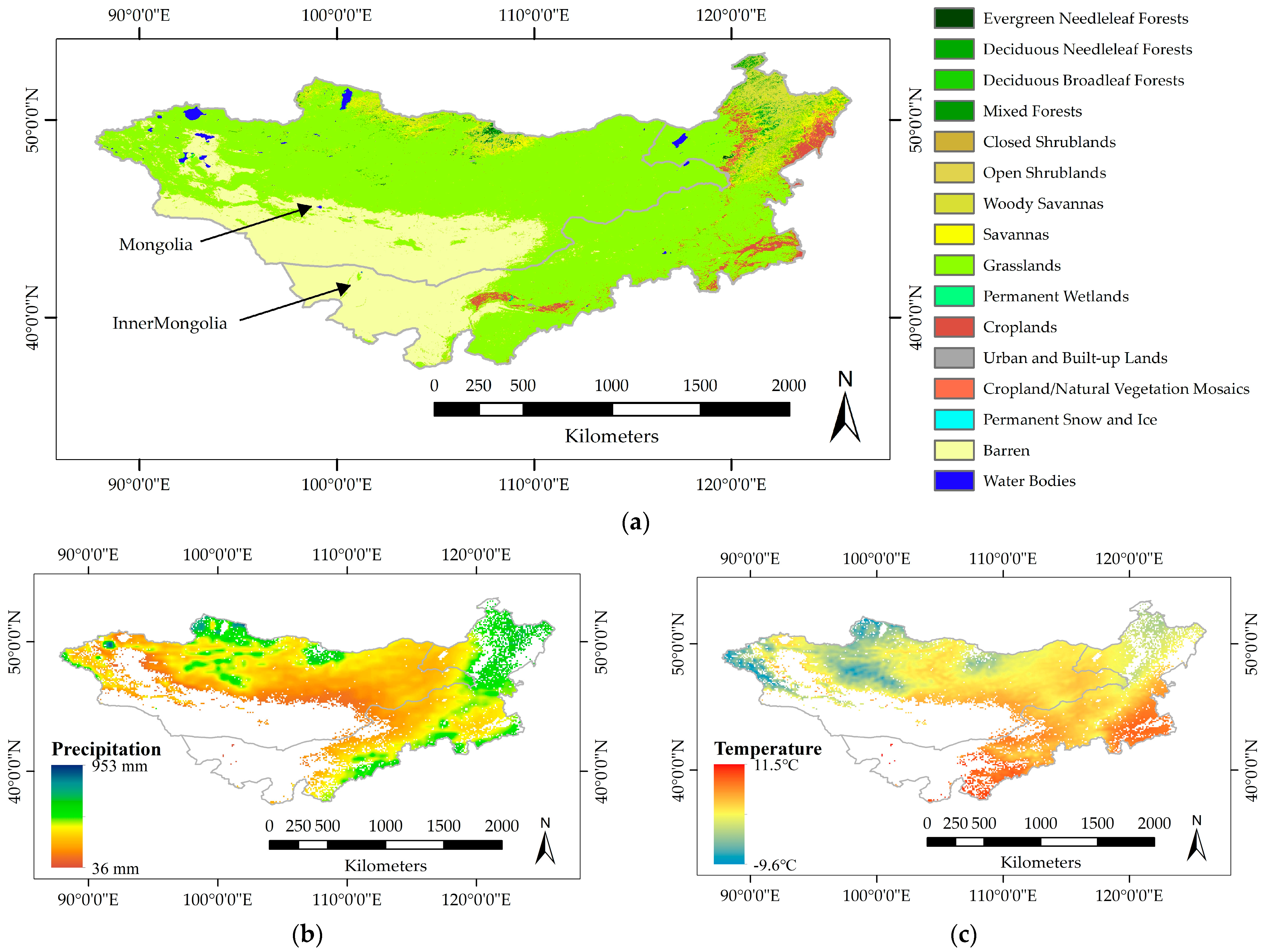



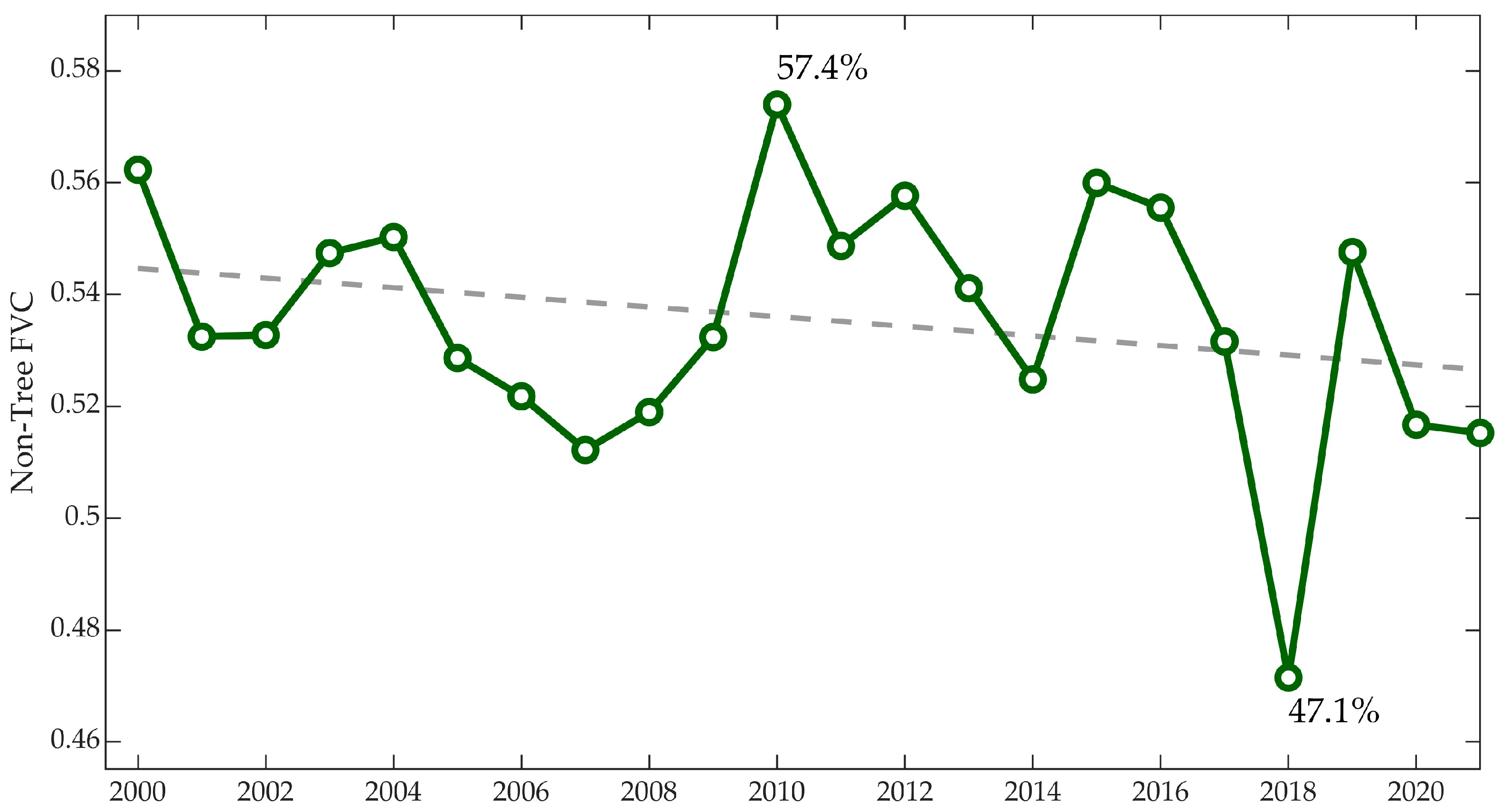
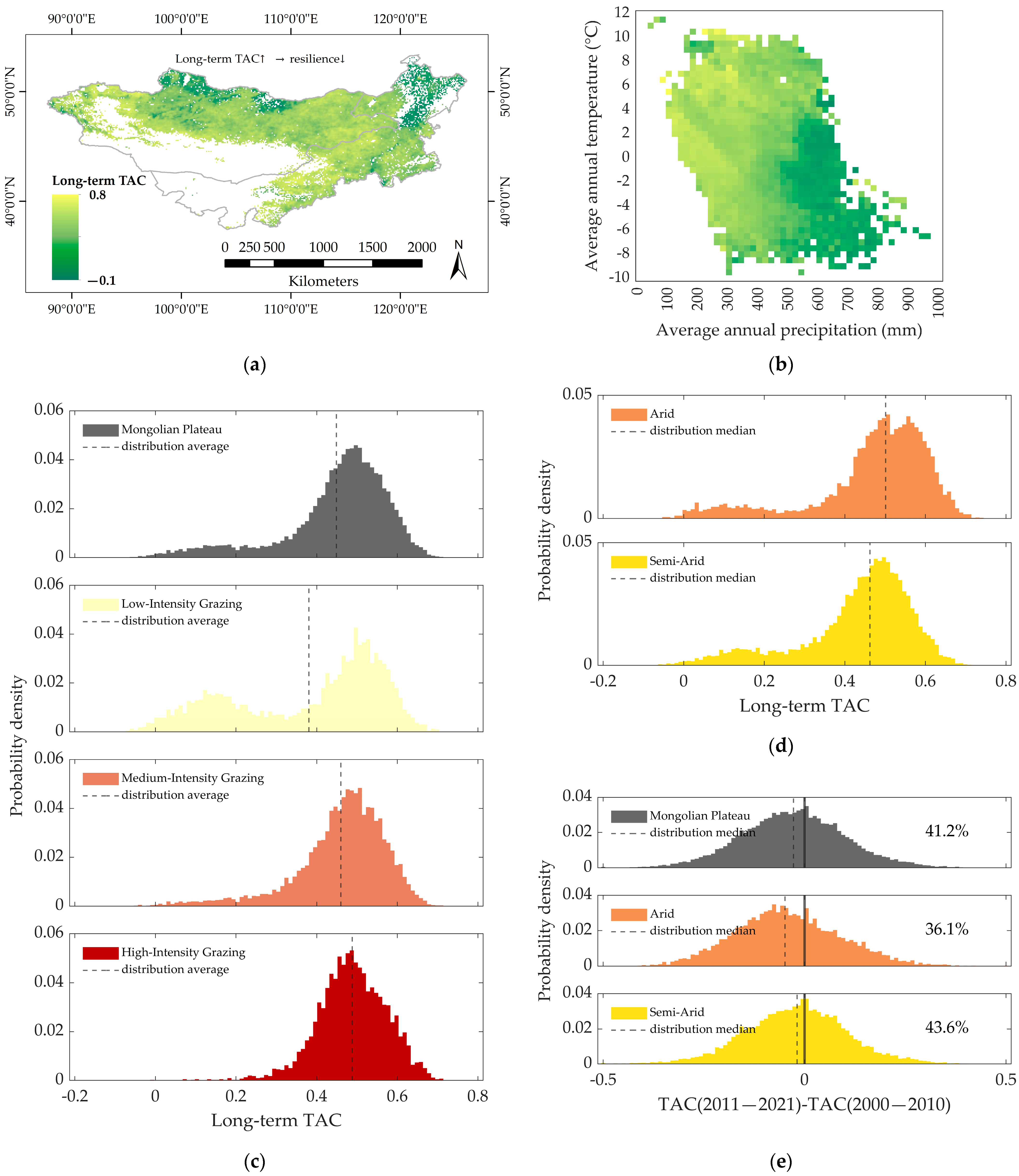

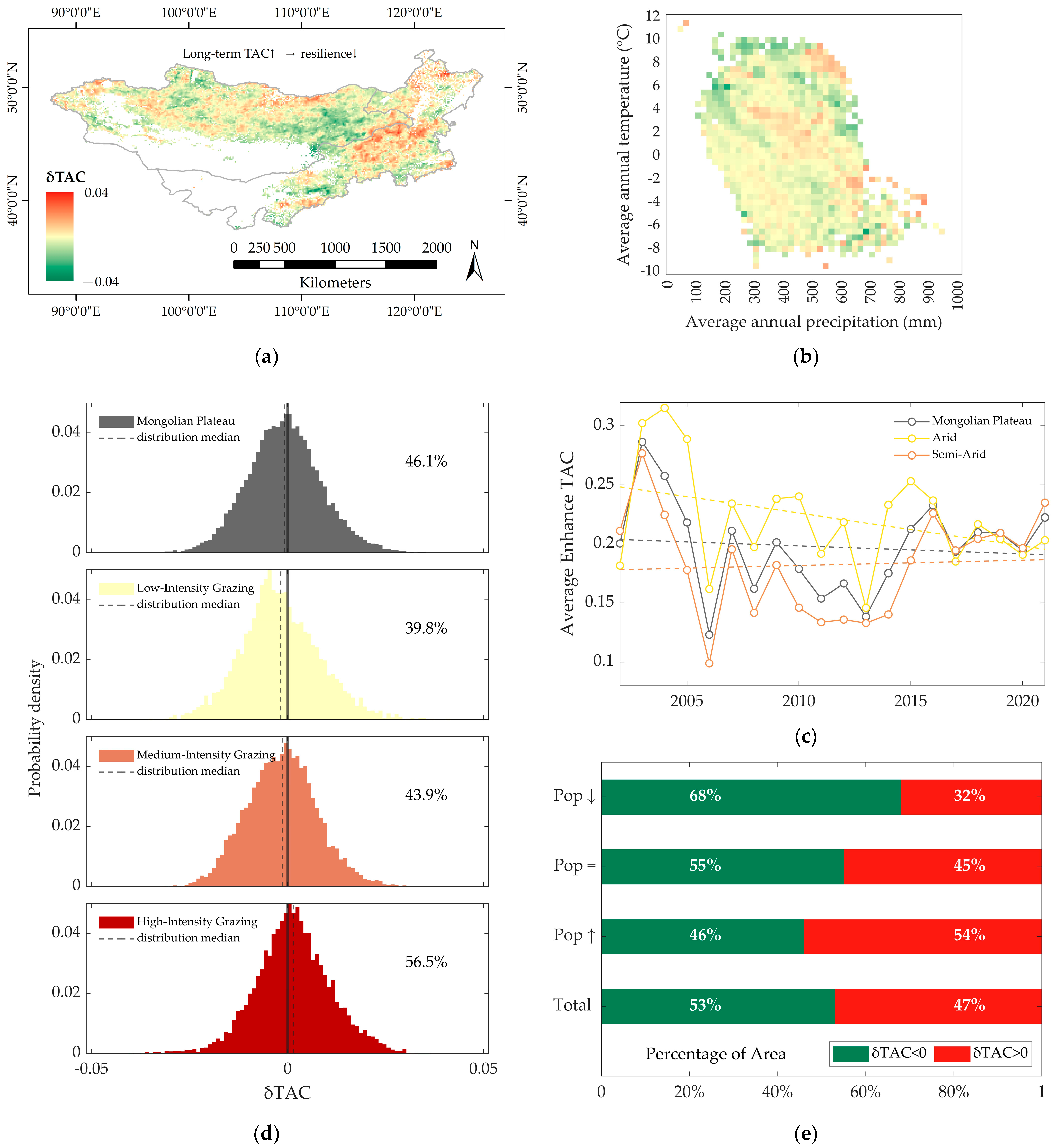
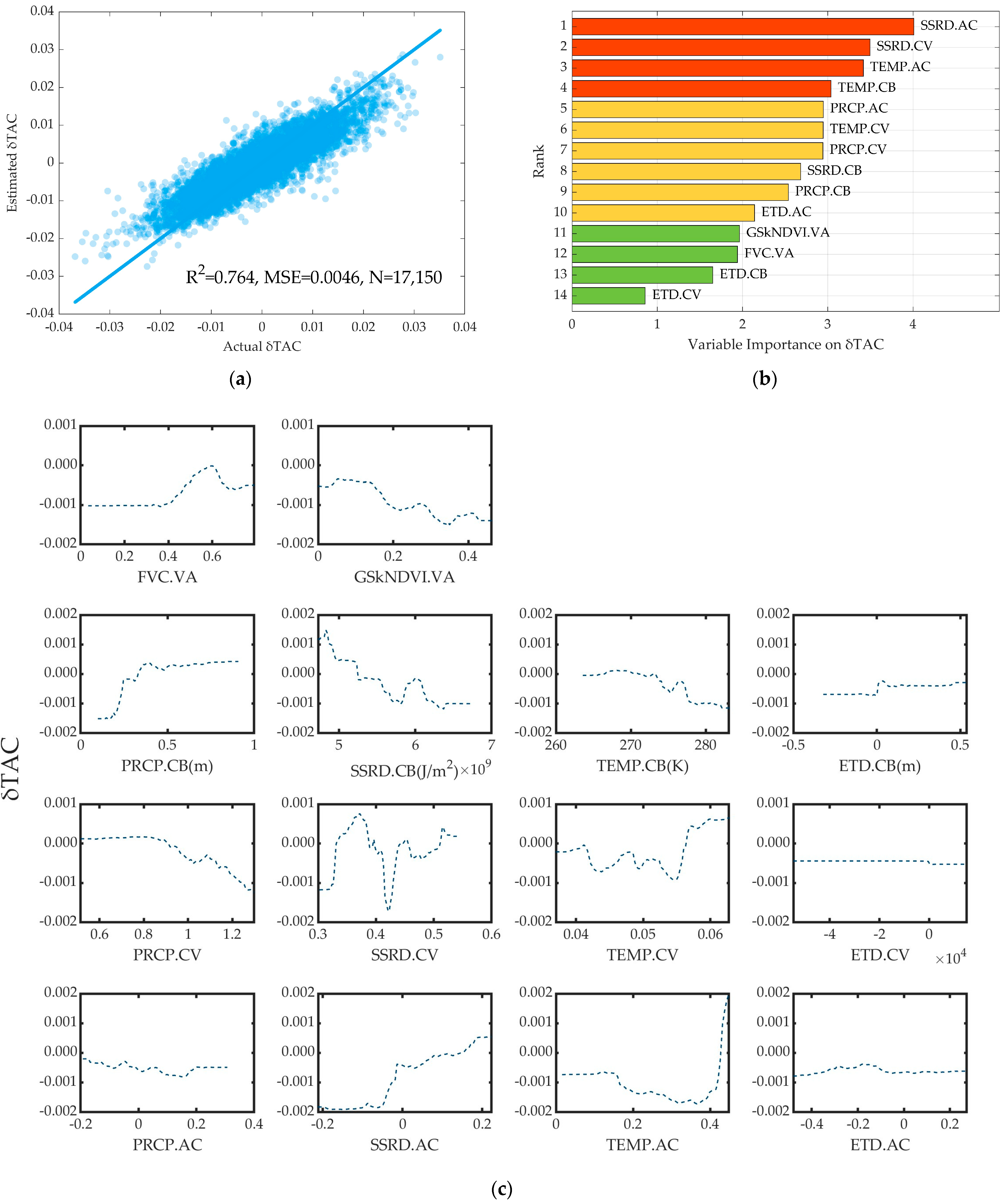
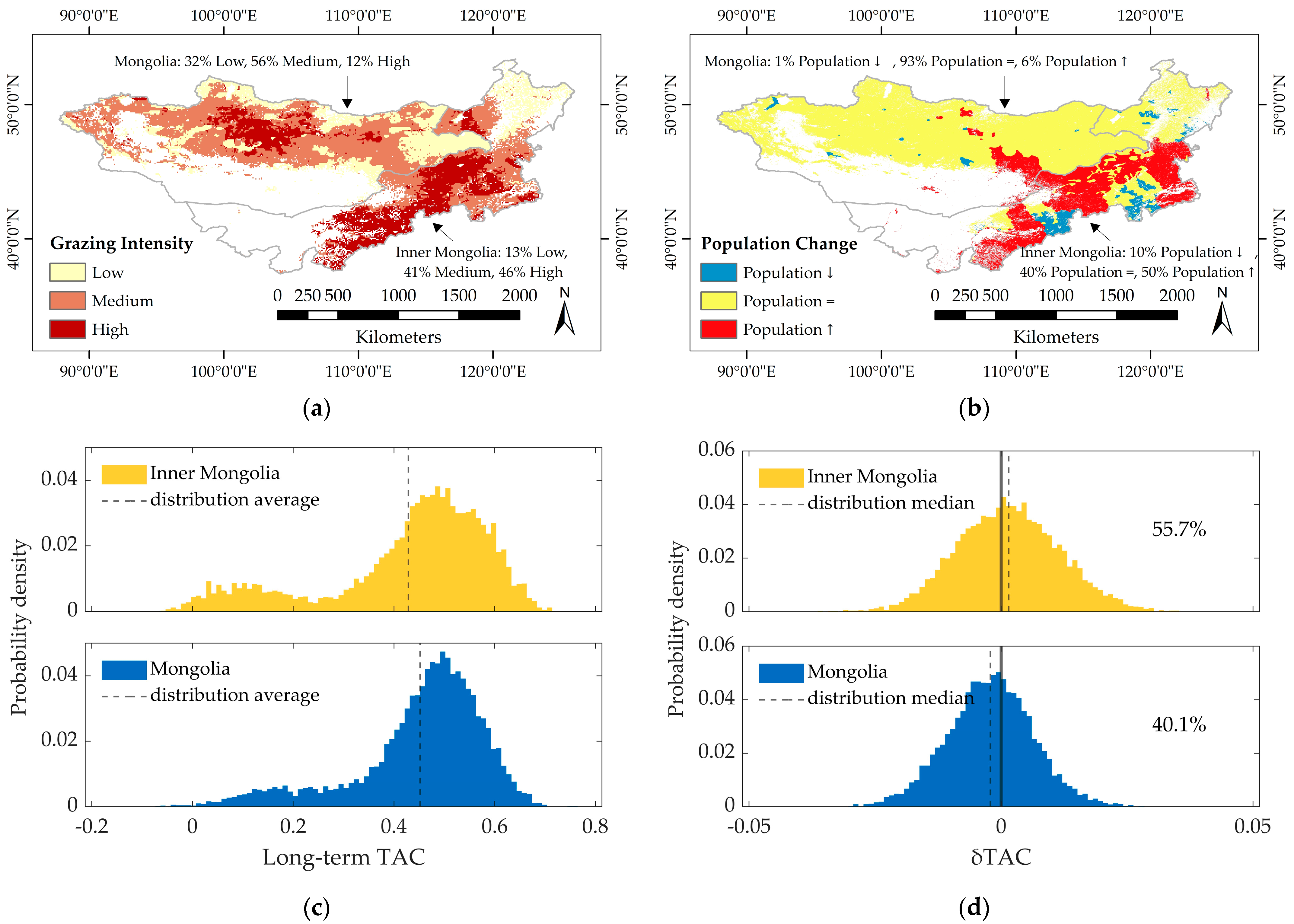
| Variable Name 1 | Category | Label |
|---|---|---|
| Average Nontree Fractional Vegetation Cover | Vegetation Attributes | FVC.VA |
| Growing-season-averaged kNDVI | Vegetation Attributes | GSkNDVI.VA |
| Average 2 m Air Temperature | Climate Background | TEMP.CB |
| Variable Coefficient of 2 m Air Temperature | Climate Variability | TEMP.CV |
| Temporal Autocorrelation of 2 m Air Temperature | Climate Autocorrelation | TEMP.CA |
| Average Surface Solar Radiation Downwards | Climate Background | SSRD.CB |
| Variable Coefficient of Surface Solar Radiation Downwards | Climate Variability | SSRD.CV |
| Temporal Autocorrelation of Surface Solar Radiation Downwards | Climate Autocorrelation | SSRD.CA |
| Average Total Precipitation | Climate Background | PRCP.CB |
| Variable Coefficient of Total Precipitation | Climate Variability | PRCP.CV |
| Temporal Autocorrelation of Total Precipitation | Climate Autocorrelation | PRCP.CA |
| Average Evapotranspiration Deficit | Climate Background | ETD.CB |
| Variable Coefficient of Evapotranspiration Deficit | Climate Variability | ETD.CV |
| Temporal Autocorrelation of Evapotranspiration Deficit | Climate Autocorrelation | ETD.CA |
| Inner Mongolia | Mongolia | Mongolian Plateau | |||||
|---|---|---|---|---|---|---|---|
| Mean | CV 1 | Mean | CV | Mean | CV | ||
| Whole | 0.0015 | 6.7743 | −0.0021 | −3.9831 | −0.0007 | −12.8030 | |
| Low-Intensity | 0.0035 | 2.8290 | −0.0028 | −3.3634 | −0.0017 | −5.6944 | |
| Medium-Intensity | 0.0004 | 23.1531 | −0.0022 | −3.7341 | −0.0014 | −6.4395 | |
| High-Intensity | 0.0022 | 4.7340 | −0.0002 | −29.7911 | 0.0015 | 6.4951 | |
| Population ↑ 2 | 0.0026 | 4.2351 | −0.0083 | −1.0288 | 0.0009 | 12.0709 | |
| Population = | 0.0020 | 4.4488 | −0.0017 | −4.8079 | −0.0009 | −9.2848 | |
| Population ↓ | −0.0038 | −2.4678 | −0.0001 | −167.7656 | −0.0032 | −3.0504 | |
Disclaimer/Publisher’s Note: The statements, opinions and data contained in all publications are solely those of the individual author(s) and contributor(s) and not of MDPI and/or the editor(s). MDPI and/or the editor(s) disclaim responsibility for any injury to people or property resulting from any ideas, methods, instructions or products referred to in the content. |
© 2023 by the authors. Licensee MDPI, Basel, Switzerland. This article is an open access article distributed under the terms and conditions of the Creative Commons Attribution (CC BY) license (https://creativecommons.org/licenses/by/4.0/).
Share and Cite
Wu, J.; Sun, Z.; Yao, Y.; Liu, Y. Trends of Grassland Resilience under Climate Change and Human Activities on the Mongolian Plateau. Remote Sens. 2023, 15, 2984. https://doi.org/10.3390/rs15122984
Wu J, Sun Z, Yao Y, Liu Y. Trends of Grassland Resilience under Climate Change and Human Activities on the Mongolian Plateau. Remote Sensing. 2023; 15(12):2984. https://doi.org/10.3390/rs15122984
Chicago/Turabian StyleWu, Jincheng, Ziyun Sun, Ying Yao, and Yanxu Liu. 2023. "Trends of Grassland Resilience under Climate Change and Human Activities on the Mongolian Plateau" Remote Sensing 15, no. 12: 2984. https://doi.org/10.3390/rs15122984






